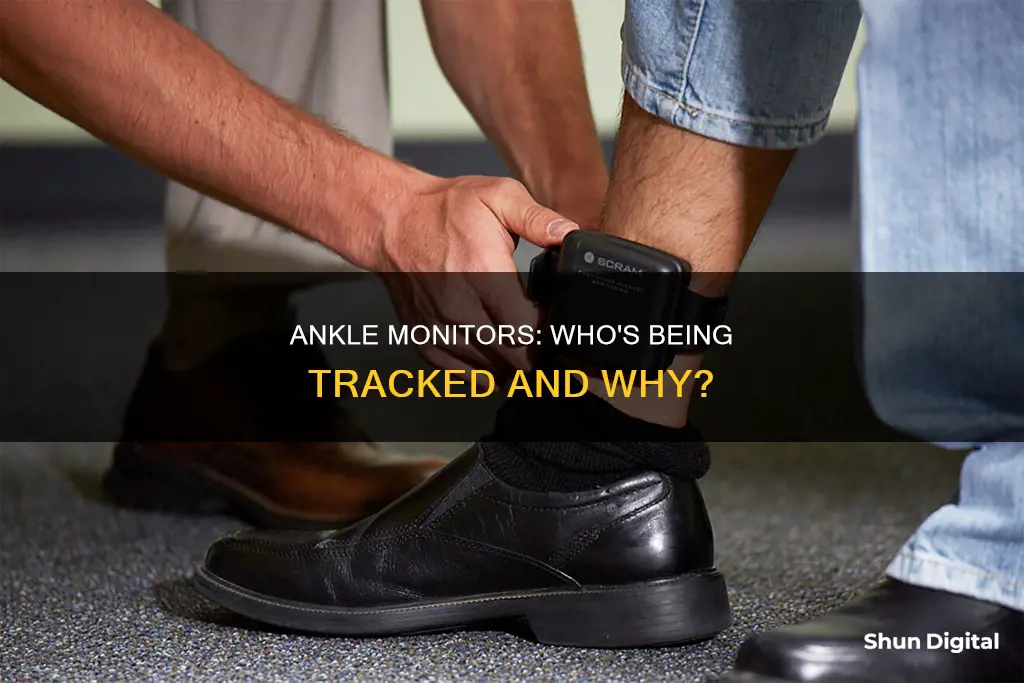
Ankle monitors are often used as an alternative to incarceration, with the goal of allowing individuals to maintain a family life and participate in treatment while also ensuring they don't reoffend. The use of electronic monitoring has increased in recent years, with the number of people under electronic supervision in the US rising from 53,000 in 2005 to 125,000 in 2015. Ankle monitors are typically used for individuals who are awaiting trial, on probation or parole, or facing immigration proceedings. They can also be used as a condition of bail or as an alternative to a jail sentence for low-risk or non-violent offenders. The monitors use GPS technology to track the wearer's location and can be set up to detect when the wearer enters or leaves a specific area, or comes into proximity with certain individuals. While ankle monitors are intended to reduce recidivism and keep communities safe, critics argue that they fail to meet these goals and can actually lead to further marginalization and stigmatization of monitored individuals.
What You'll Learn

Criminal defendants awaiting trial
Ankle monitors are electronic devices equipped with GPS technology that track the wearer's location at all times. They are usually strapped to the ankle with a tamper-proof band and must be worn for as long as the judge orders. These devices use radio frequency signals to communicate with a monitoring station and can be programmed to allow wearers to roam within a certain perimeter. If the wearer goes outside the designated area, the device vibrates and emits a loud tone, notifying them that they are about to violate the conditions of their release.
The use of ankle monitors can vary depending on the jurisdiction, the severity of the crime, and the individual's criminal history. However, some common situations where a judge may order the use of an ankle monitor include serious crimes such as murder, sexual assault, or major drug offenses; for repeat offenders; in cases of domestic violence; and for individuals with DUI or DWI convictions.
While ankle monitors are promoted as a more humane alternative to jail, there are also concerns about the cost burden they place on defendants, who are often required to pay daily or monthly fees to private companies for the use of the device. Additionally, the constant surveillance and lifestyle restrictions that come with ankle monitors can be mentally taxing and make it difficult for individuals to find and keep employment.
Uninstalling Old Monitor Drivers: A Step-by-Step Guide
You may want to see also

People on probation or parole
The ankle monitors also serve as a deterrent and a means of ensuring compliance with the conditions of probation or parole. For example, individuals may be required to refrain from consuming alcohol or drugs, and the ankle monitor can be equipped with alcohol or drug detection capabilities. This information is then relayed to the relevant authorities, including probation officers. Additionally, the devices may be programmed to detect proximity to certain individuals, such as victims of domestic violence or abuse, and alert authorities if the monitored individual approaches or enters a prohibited area.
The consequences of violating the terms of probation or parole while wearing an ankle monitor can be severe. Any attempt to tamper with, damage, or remove the device will automatically trigger a signal to law enforcement, resulting in potential arrest and further legal repercussions. Non-compliance with the court-ordered conditions, such as failing to meet with a probation officer, abstain from restricted activities, or stay within designated areas, can lead to increased monitoring, revocation of parole, or jail time.
While ankle monitors are commonly associated with individuals on probation or parole, it is important to note that their use varies based on jurisdiction, the severity of the crime, and the individual's criminal history. In some cases, ankle monitors may be used as an alternative to pre-trial detention or as a condition of bail, especially for low-risk or non-violent offenders. The decision to impose ankle monitors is typically made by a judge based on the specific circumstances of each case, taking into account factors such as flight risk, danger to the community, and the individual's criminal background.
Monitoring Table Sizes on Unix: A Comprehensive Guide
You may want to see also

People under house arrest
Ankle monitors are often used as an alternative to pre-trial detention or as a condition of probation. They are typically court-mandated for individuals who are considered a danger to the community or a flight risk. By wearing an ankle monitor, individuals can avoid incarceration while awaiting trial or as part of their parole conditions. The monitors help law enforcement track an individual's compliance with court-ordered restrictions, such as curfews or exclusion zones.
The use of ankle monitors has been a subject of debate. Proponents argue that electronic monitoring is more humane, allowing individuals to live at home and maintain family connections. It also saves costs for cash-strapped states and gives offenders the opportunity to become productive members of society. Additionally, it can be used to supervise high-risk offenders and reduce the risk of recidivism.
On the other hand, critics argue that ankle monitors fail to effectively reduce recidivism and can undermine rehabilitation by severing an individual's ties to the community. The monitors can also lead to frequent technical failures and false alarms, impacting the productivity of law enforcement. Additionally, the associated fees for wearing these devices can be a financial burden, especially for households already dealing with the return of an incarcerated loved one. The stigma and social isolation associated with wearing an ankle monitor can also exacerbate mental health issues for the wearer.
In summary, while ankle monitors provide an alternative to incarceration for people under house arrest, there are concerns about their effectiveness in reducing recidivism and their potential negative impact on the wearers' mental health and social connections.
Dismantling Monitors to Remove Dead Bugs: Worth the Effort?
You may want to see also

People facing immigration proceedings
In the United States, the use of electronic monitoring for immigrants has increased significantly in recent years, particularly under the Trump administration. In 2018, the Immigration and Customs Enforcement (ICE) issued thousands of ankle monitors to immigrants, referring to them as "grilletes" or "electronic shackles". While the government claims that these devices ensure people show up for their immigration court proceedings, immigrant advocates argue that they are physically and psychologically harmful to asylum seekers, many of whom have experienced persecution and trauma in their home countries.
The use of ankle monitors on immigrants has been linked to the issue of family separation. In 2018, the Trump administration cancelled the Family Case Management program, which steered approximately 1,000 migrants, often pregnant women or mothers, through the immigration court system. Instead, these individuals were required to wear ankle monitors.
In addition to the physical discomfort and embarrassment caused by ankle monitors, immigrants also face the constant fear of being watched and controlled by the government. They must adhere to strict curfews and risk re-detention if their monitor's battery dies or if they accidentally stray outside their assigned area.
While proponents of electronic monitoring argue that it is a more humane alternative to detention, allowing individuals to live with their families and participate in treatment, critics counter that it undermines rehabilitation by severing a person's ties to the community and infringing on their privacy. Furthermore, the cost of renting and maintaining these devices can be a financial burden for immigrants, with daily fees ranging from $5 to $25.
The effectiveness of ankle monitors in ensuring the appearance of immigrants at their court hearings is also questionable. Some immigrants ditch their monitors and disappear, and there is a lack of reliable information on the number of individuals who do so.
Overclocking Your ASUS Monitor to 75Hz: A Step-by-Step Guide
You may want to see also

DUI or DWI defendants
DUI (Driving Under Influence) or DWI (Driving While Intoxicated) defendants often have to wear ankle monitors as a condition of their bail or parole. These monitors are used to ensure that the defendant does not consume alcohol and abides by the court's orders. Ankle monitors are usually ordered for repeat DUI or DWI offenders, as they are considered an active danger to the public and a flight risk.
The ankle monitor, also known as a SCRAM (Secure Continuous Remote Alcohol Monitor) device, is a bracelet that is worn around the ankle or lower leg. It continuously monitors the wearer's perspiration for alcohol content, usually every 30 minutes to 30 seconds, 24 hours a day. The device is similar to a breathalyzer as it measures the blood alcohol concentration (BAC) of the wearer. The data is then sent to a computer database and eventually ends up with the courts and the probation officer.
The SCRAM device is water-resistant and has sophisticated anti-tampering mechanisms. If the wearer attempts to remove or tamper with the device, an alert is immediately sent to the monitoring center and the probation officer. This is considered a probation violation and can result in additional penalties, including jail time and prolonged probation.
In addition to the ankle monitor, DUI or DWI defendants may also be required to attend AA meetings, submit to random urine tests, and allow visits from their probation officers. The use of ankle monitors for these defendants is an alternative to pre-trial detention or jail time, allowing them to live at home and maintain their family life and employment.
The cost of a SCRAM device can be significant, with installation fees ranging from $50 to $100 and daily monitoring fees of around $10 to $15. These fees are typically paid by the defendant as part of their penalty for the DUI conviction.
Monitor Usage: Afterburner's Impact and Performance Revealed
You may want to see also
Frequently asked questions
Ankle monitors are typically worn by people who are on house arrest, probation, or parole. They are also worn by people awaiting trial, serving probation or parole, and those facing immigration proceedings.
Ankle monitors are used to track and monitor an individual's movements outside of a prison, jail, or detention center. They are often used as an alternative to incarceration or pre-trial detention.
Ankle monitors use GPS technology to track an individual's location. They can also be equipped with other features such as alcohol monitoring, voice recognition, and biometric security systems.
The rules for people wearing ankle monitors can vary depending on the situation. They may include sticking to a specific area, avoiding certain people, adhering to a curfew, or refraining from drugs and alcohol.
If someone tries to remove or tamper with an ankle monitor, it will automatically send a signal to law enforcement authorities. This can result in legal consequences such as jail time, fines, or tighter restrictions.







